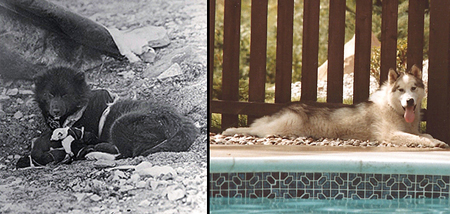From the Editor... Words Worth Repeating
Qillarsuaq
The Endurance Dogs
The Concept of an Aboriginal Dog Breed
Inuit Tradition in 75 Tons of Sand!
The Canadian Animal Assistance Team’s 2013 Northern Canada Animal Health Care Project
Far Fur Country Project Update
Movie Review: Arctic Dog Team, Arctic Jungle, Arctic Hunter
IMHO... Well, That's The Way We Do It!
Navigating This Site
Index of articles by subject
Index of back issues by volume number
Search The Fan Hitch
Articles to download and print
Ordering Ken MacRury's Thesis
Our comprehensive list of resources
Defining the Inuit Dog
Talk to The Fan Hitch
The Fan Hitch home page
Editor: Sue Hamilton
Webmaster: Mark Hamilton
The Fan Hitch, Journal
of the Inuit Sled Dog, is published four
times a year. It is available at no cost
online at: https://thefanhitch.org.
The Fan Hitch welcomes your letters, stories, comments and suggestions. The editorial staff reserves the right to edit submissions used for publication.
Contents of The Fan Hitch are protected by international copyright laws. No photo, drawing or text may be reproduced in any form without written consent. Webmasters please note: written consent is necessary before linking this site to yours! Please forward requests to Sue Hamilton, 55 Town Line Rd., Harwinton, Connecticut 06791, USA or mail@thefanhitch.org.
This site is dedicated to the Inuit Dog as well as related Inuit culture and traditions. It is also home to The Fan Hitch, Journal of the Inuit Sled Dog.
The Fan Hitch welcomes your letters, stories, comments and suggestions. The editorial staff reserves the right to edit submissions used for publication.
Contents of The Fan Hitch are protected by international copyright laws. No photo, drawing or text may be reproduced in any form without written consent. Webmasters please note: written consent is necessary before linking this site to yours! Please forward requests to Sue Hamilton, 55 Town Line Rd., Harwinton, Connecticut 06791, USA or mail@thefanhitch.org.
This site is dedicated to the Inuit Dog as well as related Inuit culture and traditions. It is also home to The Fan Hitch, Journal of the Inuit Sled Dog.

| Dog with pups at Bernard
Harbour, Northwest Territories (Nunavut); 21 June 1915. Photo: Sir George Hubert Wilkins, 1888-1958. Courtesy of the Canadian Museum of Civilization: 51568;
CD2003-0401-00
|
Barry, an Alaskan Malamute,
relaxes after a cooling swim in his in-ground pool. Photo: E. Jouvet |
Well, That’s The Way We Do
It!
by Mark Hamilton
by Mark Hamilton
I think that sometimes we find it easier or preferable not to think. In some circumstances it seems as if there isn’t time to stop and think things through, our perception is that immediate action is required. On other occasions you’d just prefer to not think about something and you choose to simply react instead. And on still other occasions your response is “Well, this is the way I’ve always done this.” It’s not solely individuals that need to deal with these types of situations and respond in these ways. Government and its various bureaucracies also confront this, plus various organizations and businesses as well.
So, what happens? Sometimes things work out, other times not so much. Personally, when I find myself in these types of circumstances I endeavor to keep Albert Einstein’s definition of insanity – “doing the same thing over and over again and expecting different results” – in mind and to continuously evaluate if what I’m doing is actually working.
Starting in March 2009, The Fan Hitch published in four parts Vladimir Beregovoy’s work “Evolutionary Changes In Domesticated Dogs: The Broken Covenant Of The Wild”. Beregovoy’s article delineated many differences between aboriginal dogs and cultured breeds while defining the term: aboriginal. Further, he presented models of their reproductive biology, behavior, way of life and selection, then contrasted them with that of cultured breeds.
Johan and Edith Gallant’s article, “Breed, Landrace and Purity: what do they mean?” was published in the December 2010 edition of The Fan Hitch. The article presented definitions for the terms landrace and breed as well walked us through the concept of purity. Landrace dogs (aboriginal dogs) were described as unique to their ecology/geography as well as their uses. While some human influence was acknowledged in terms of preference, they were described as, “largely the result of environmental adaptation, mostly under conditions of natural selection.”
Beregovoy’s and the Gallant’s articles highlight the unique position aboriginal dogs (landrace dogs) occupy between the feral wolf and cultured dog breeds and perhaps even account for the interest various researchers have lately expressed in landrace dogs in their search for the origin of dog domestication.
In 1839 the Esquimaux Dog (Inuit Dog) was described by Lt. Col. C.H. Smith (naturalist, illustrator and artist in addition to his military career), and he identified the dog as Canis borealis. And so the Inuit Dog was known as Canis familiaris ‘borealis’...until recently. The Inuit Dog is now identified as just Canis familiaris, lumped in with every other domestic dog. I guess it’s just a case of “a dog is a dog is a dog” for the people who oversee taxonomic naming. I think it’s reasonable to ask, “Why?” I also think it’s reasonable to ask why all aboriginal dogs are now also lumped into Canis familaris with all those cultured breeds. What I’m not doing is offering any answers to those questions. Answering them is better left to someone who achieved much more success in the educational system than I did. But I will say that for me, classifying landrace dogs as just another dog among all those cultured breeds is akin to concluding that whatever caused the mass extinction of all but the avian dinosaurs at the end of the Cretaceous period was just another meteor impact.